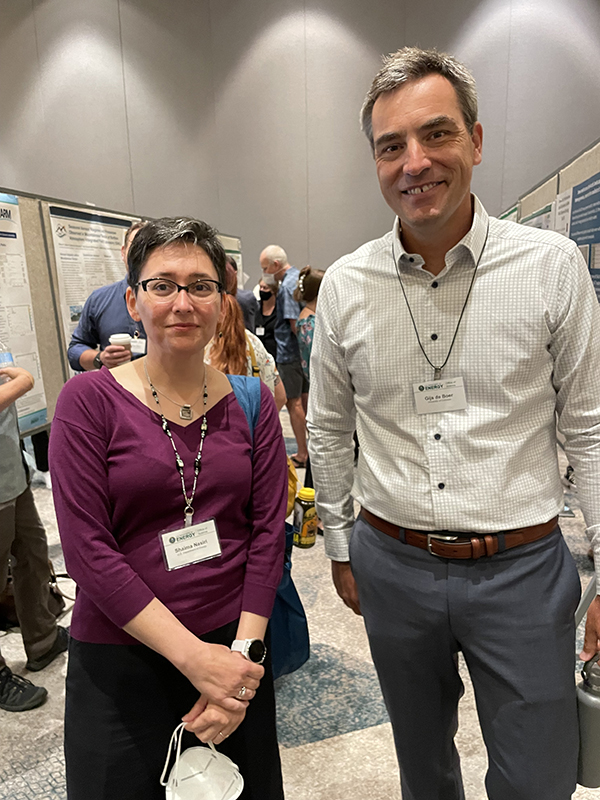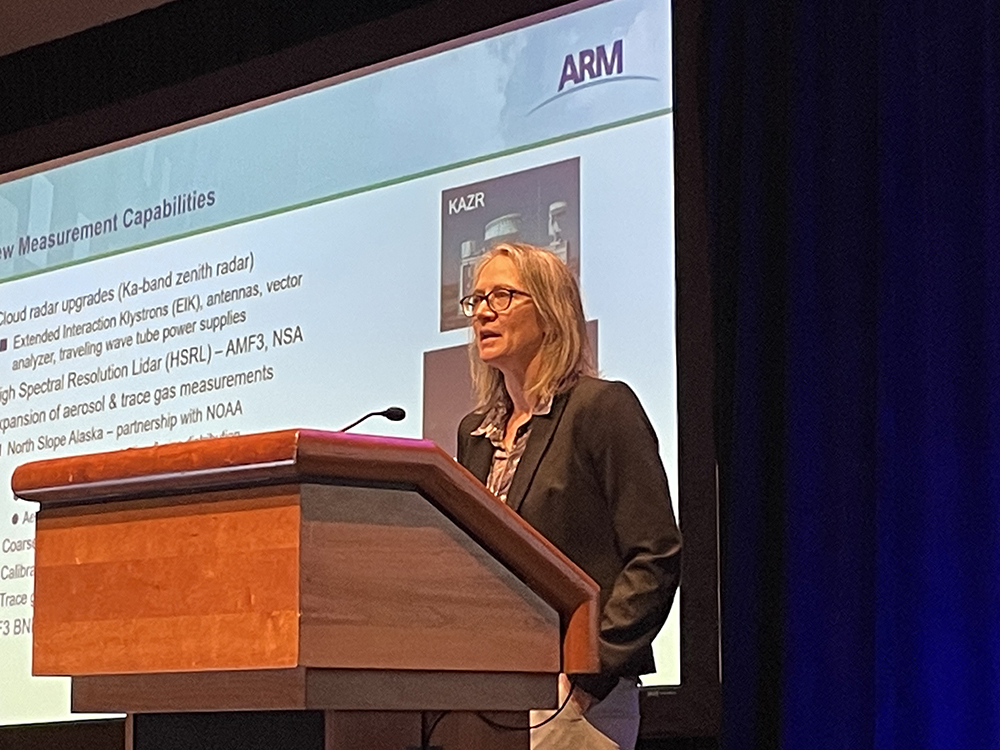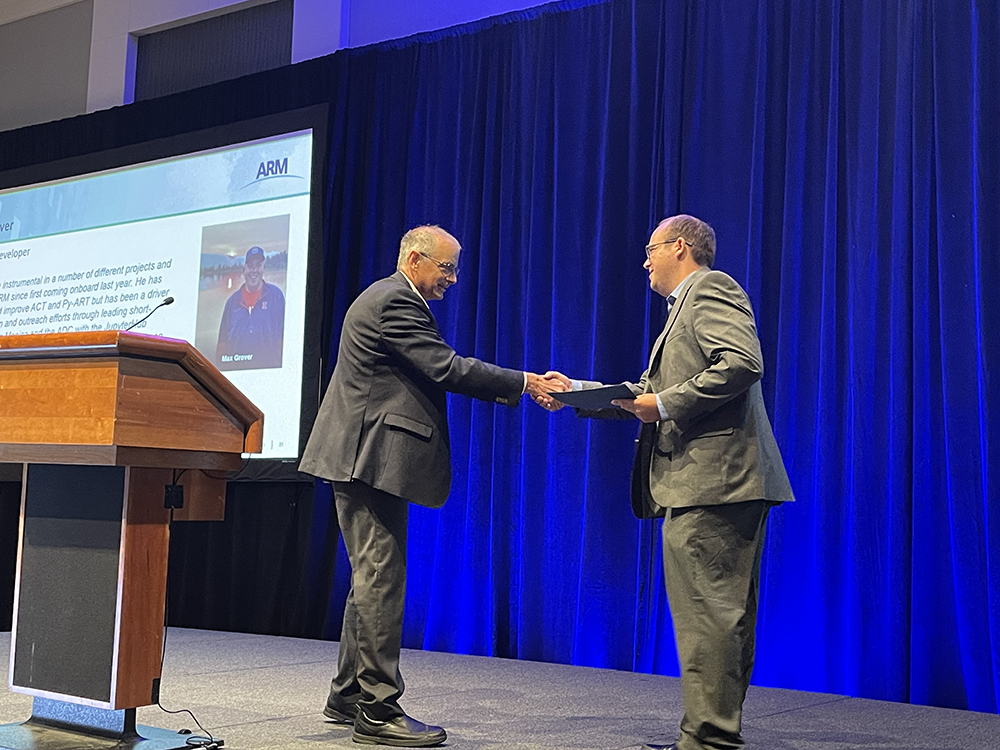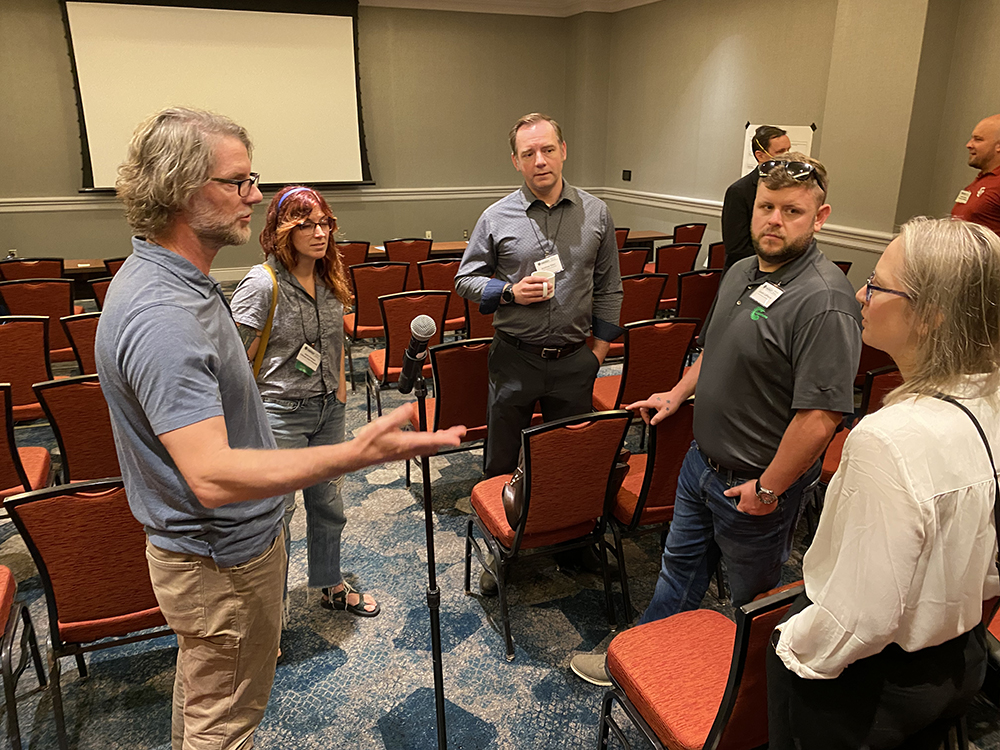2023 ARM/ASR Joint Meeting Brings Welcome Deluge of Updates
Published: 31 August 2023
Over four days, atmospheric scientists renew ties, share new science, and imagine the future

On the afternoon of August 7, 2023, a gray wall of rain bore down on Rockville, Maryland. It was followed by steady threads of lightning and even a tornado watch.
Inside a Rockville Marriott, atmospheric scientists stayed safe and dry while tracking the storm on their mobile phones. They discussed real-time cloud cells, rain intensity, and signs of tornadic rotation.
“It’s a conference on storms, interrupted by a storm,” observed self-described weather nerd Scott Collis of Argonne National Laboratory in Illinois.
He was among 421 attendees, 127 of them online, at the conference, sponsored by the U.S. Department of Energy (DOE) Atmospheric Radiation Measurement (ARM) user facility and Atmospheric System Research (ASR) program.
Organizers said the number of attendees at the August 7─10 meeting exceeded the annual average by 100.
Over four days, the 2023 Joint ARM User Facility/ASR Principal Investigators Meeting—or joint meeting for short—rained research and poured data. During breaks, poster sessions, and meals, conversations flashed like lightning.
Following tradition, there were morning plenaries; breakout sessions; working-lunch presentations, which this year featured ARM constituent groups, climate science communication, and undergraduate engagement; and poster sessions, an open bazaar of ideas and accomplishments.
Just a glimpse of what the posters offered: updated research on new particle formation, canopies in complex terrain, optical properties of brown carbon, Southern Ocean ice processes, sea-salt plumes, cold pools, warm clouds, updraft width, and isoprene in tropical forests.
Welcomes and the Future

The first plenary session opened with welcomes, of course.
One was from Todd Anderson, the acting associate director of DOE’s Biological and Environmental Research (BER) program.
Another was from Gary Geernaert, director of BER’s Earth and Environmental Systems Sciences Division.
He touched on budget (flat, at best, with a chance of growth); people (“tough and fabulous”); and priorities in the next five years or more.
Among the priorities: strengthen ARM and ASR ties with the modeling community, including DOE’s Energy Exascale Earth System Model (E3SM); further embrace edge computing and machine learning; continue digging into land-atmosphere interactions, illustrated by ARM’s impending long-term atmospheric observatory in Alabama’s Bankhead National Forest; and embrace the hope that quantum computing will “have a presence” in the joined spheres of ARM and ASR.
ASR News and Numbers

As always, the opening plenary included updates on ARM and ASR.
ASR Program Manager Shaima Nasiri opened her update by noting the Office of Science’s commitment to professional conduct in the field and the office to ensure safe, diverse, and inclusive work environments.
There was news, too. Nasiri announced changes in working group leadership, including arctic researcher Gijs de Boer and convective cloud scientist Adam Varble stepping down from their positions as co-chairs of the high-latitude processes and convective processes working groups.
Aerosols expert Jessie Creamean is stepping up to co-lead the high-latitude processes working group. Dié Wang will co-lead the convective processes working group.
In workshop news, the DOE-NOAA Marine Cloud Brightening Workshop Report is available; a Future of Atmospheric Large-Eddy Simulation report is expected no later than early fall 2023; and a small ASR-sponsored workshop on ice processes is slated for October 2023.
News with numbers: Starting in fall 2023, ASR will fund 24 new research awards of up to three years each. Nasiri also told the audience to look for fiscal year 2024 (FY2024) research calls for targeted ASR proposals and for the Office of Science Early Career Research Program.
In addition, Nasiri called on scientists to submit research highlights to share their work with the public. From January 1, 2022, to July 20, 2023, 109 such science narratives were published.
ARM Updates

ARM Program Manager Sally McFarlane shared some news and numbers of her own, reporting 1,113 ARM scientific users in FY2022, including 702 data users.
In her capability updates, she noted planned new lidar and aerosol capabilities at the North Slope of Alaska atmospheric observatory and C-band radar additions to the ARM Mobile Facility.
After releasing large-eddy simulations of deep convection observed in Argentina, the team overseeing ARM’s high-resolution modeling activity is starting to plan for a new set of simulations focused on the marine boundary layer over ARM’s Eastern North Atlantic atmospheric observatory in the Azores.
Meanwhile, ARM is preparing to open the Bankhead National Forest observatory by the end of 2023. ARM leaders also expect the first science flights of the Challenger 850 research aircraft in FY2025.
McFarlane added requests for users to properly acknowledge ARM in research papers and to review and update their ARM accounts.
To be counted as an active ARM science user in a given year, an account holder must download data for scientific research, use the facility’s high-performance computing resources, be a principal or co-investigator on an approved ARM field campaign, or visit a site to do field research.
McFarlane also provided what everyone was waiting for: news on ARM field campaigns. The Eastern Pacific Cloud Aerosol Precipitation Experiment (EPCAPE), a yearlong look at marine clouds in Southern California, is still underway.
A complementary study jointly funded by ASR and the Office of Naval Research unfolded in June 2023. The Southern California Interactions of Low cloud and Land Aerosol (SCILLA) experiment racked up almost 90 hours of research flights, which are expected to add regional atmospheric context to EPCAPE’s more localized point measurements.
Farther afield, instruments will ship out in the next few weeks for the Tasmania-based Cloud And Precipitation Experiment in Kennaook (CAPE-K), a 17-month investigation of Southern Ocean cloud and precipitation properties. Operations begin in April 2024.
A newly announced field campaign, the Coast-Urban-Rural Atmospheric Gradient Experiment (CoURAGE), could start as early as fall 2024. Its aim is to study the region’s mixed influences on the atmosphere in Baltimore, Maryland, and two ancillary sites, one bayside and one rural.
McFarlane said one of three new tethered balloon system (TBS) campaigns will support CoURAGE. Another will take vertical snapshots of aerosols at ARM’s Southern Great Plains observatory in Oklahoma, and a third will test a novel kind of aerial spectroscopy instrumentation.
She also urged plenary attendees to watch for ARM proposal solicitations on new ARM Mobile Facility campaigns, TBS work, flights by the ArcticShark uncrewed aerial system, and small, guest-instrumented campaigns.
E3SM Collaborations
Xujing Jia Davis, program manager for E3SM, discussed its synergies with ARM and ASR.
E3SM, a project to develop a high-resolution earth system model, is a central activity of DOE’s Earth System Model Development (ESMD) program area within the Earth and Environmental Systems Modeling (EESM) program.
E3SM work drives almost two-thirds of ESMD’s $47 million budget, said Davis, so its ties to ARM and ASR have great potential.
“We are open to collaboration,” she said.
ARM synergies with E3SM have taken or are taking three forms:
- a formal group discussion in 2022 on opportunities
- E3SM’s pending “decadal vision” document, with ARM and its data playing an important part
- a 2023 ARM modeling and communication outreach plan that focuses on E3SM.
Davis also pointed to several joint ARM/ASR partnerships with E3SM, including model validation and testing using ARM diagnostics and an ARM case library; ASR process knowledge and parameterization improvement; programs that leverage ARM’s high-resolution modeling activity; and model-data integration efforts.
Serving the Underrepresented
The processes atmospheric scientists study naturally affect human societies. Those impacts informed remarks by Brian Benscoter, manager of DOE’s Environmental System Science (ESS) program, which supports research on complex terrestrial and coastal ecological issues.
He delivered updates on recent DOE-wide initiatives that touch on science and society.
Funding for Accelerated, Inclusive Research (FAIR) is soliciting research ideas from Minority-Serving Institutions. Reaching a New Energy Sciences Workforce (RENEW) supports training opportunities at academic institutions historically underrepresented in DOE’s research portfolio.
Then there are Climate Resilience Centers, a DOE funding opportunity announced in December 2022. The idea is to establish programs at Minority-Serving Institutions to support local-level climate science that informs future research priorities.
Benscoter also brought up the National Virtual Climate Laboratory, a DOE portal launched in May 2023 to “engage and train the next generation of scientists.”
Around ARM

A lineup of ARM leadership took the stage to present, starting with ARM Associate Director for Research Jennifer Comstock.
Comstock outlined new and improved measurement capabilities; an expansion of value-added products, including boundary-layer products; machine learning applications to data quality control; and increased engagement with the broader scientific community, including with the E3SM group, other modelers, satellite experts, and partners in Europe.
A presentation by ARM Chief Data and Computing Officer Giri Prakash described plans to build an even better “data ecosystem for science.”
ARM Associate Director for Operations Nicki Hickmon presented a look at tool development, such as future ways to filter and customize information.
She reviewed progress at ARM’s impending Bankhead National Forest observatory and discussed an ambitious ARM workforce development project.

ARM Director Jim Mather delivered a rapid-fire concluding presentation on ARM facility changes and engagement, beginning with new capabilities tempered by budget constraints.
He touched on the new research aircraft, new data products, unexpected costs, the promise of the new Bankhead site, and the pain of possibly scaling back or eliminating some under-utilized instruments.
Mather encouraged attendees to engage with ARM’s constituent groups: the User Executive Committee and measurement science groups for aerosols and clouds and precipitation.
He reviewed how to connect with ARM through its website, clarified the facility’s code of conduct, and outlined user and ARM staff survey results. The surveys showed “a very strong sense of mission” among staff but reflected lower user scores for ARM online tools.
Then Mather announced the fifth annual ARM Service Awards, recognizing staff for notable contributions to ARM and its users. Three individuals and three teams received awards.
Field Campaign Updates
The back half of the first plenary provided updates on field campaigns and related technology. There were glimpses of:
- ongoing work on the science of convective cell growth from the Cloud, Aerosol, and Complex Terrain Interactions (CACTI) field campaign in Argentina
- initial science results and ongoing activities from the TRacking Aerosol Convection interactions ExpeRiment (TRACER) near Houston, Texas
- a virtual update on ARM TBS science, including some TRACER findings, launches from the Surface Atmosphere Integrated Field Laboratory (SAIL) campaign in Colorado, and a new award to investigate seasonal vertical aerosol profiles
- examples of what the ArcticShark could deliver to ARM data users, including “high-resolution images for E3SM model grids,” said Fan Mei, the ARM Aerial Facility’s science lead.
The Places You Could Go

During the first morning’s plenary session, field campaign updates opened the floodgates to the heart of the conference: three and a half days of hard-edged science, including 21 breakout sessions.
Based on field campaigns alone, imagine the places you could go: the North Slope of Alaska; beachside California; stormy Houston, Texas; a drifting icebreaker in the central Arctic; the high Andes; Tasmania on the edge of the Southern Ocean; a hydrologically critical valley in the Colorado Rockies; and a forest in northern Alabama.
Imagine atmospheric properties, features, and phenomena that dominated most talks: aerosols, cold-air outbreaks, water vapor isotopes, deep convection, ice crystal densities, black carbon, mixed-phase clouds containing ice and liquid water, and cloud droplet size.
And, of course, imagine deep looks at the tools of the atmospheric science trade, starting with hardware: radars, lidars, radiometers, uncrewed aerial systems, and tethered balloons that dangle lunchbox-size instruments.
Many talks were about tools connecting observations to the models that simulate future climate conditions: machine learning, artificial intelligence, E3SM, GitHub, and Python toolkits. A set of three breakout sessions focused on open science for ARM and ASR.
Working Groups Get Together
By the morning of August 10, the last hours of the joint meeting, the ASR working group sessions were underway.
In aerosol processes, those sessions included presentations on the CAPE-K aerosol plan, open science for the aerosol community, TRACER, EPCAPE, and the impending Bankhead National Forest observatory.
Convective cloud process researchers ran through talks on stratiform regions in big storms, vertical wind shear, machine learning to analyze western U.S. wildfire impacts, and more.

The warm boundary layer processes group took a flash-talk approach. Thirteen presenters, all investigators of this lowest layer of the atmosphere, quickly delved into subjects such as ARM data products, simulated changes in near-surface moisture, automated large-eddy circulations over land, the climatology of cold pools, and sea-salt delivery to the clouds.
Meanwhile, the high-latitude working group presentations looked at CAPE-K; ARM value-added products for high-latitude sites; data on ice-nucleating particles from Oliktok Point, Alaska; and ARM’s role in the Multidisciplinary Drifting Observatory for the Study of Arctic Climate (MOSAiC) expedition. So far, this 20-country, 400-scientist expedition has spun off 100-plus papers, with at least 30 more in the works.
After their session, the high-latitude researchers lingered to bat around an idea that had emerged at the end: instrumented airships that could sweep over the Earth’s colder regions, taking in big data on little air parcels for what are called “Lagrangian” models.
High-latitude airships are an example of what science meetings are really for: new ideas.
Said de Boer, the arctic researcher: “It’s not crazy.”
Closing Business
If you missed the joint meeting, you can browse plenary and breakout session presentation slides on the meeting agenda web page.
Posters and abstracts are also available online.
If you presented and still need to submit your slides or a breakout session summary report, please upload your materials to help ensure a more complete meeting archive.
Keep up with the Atmospheric Observer
Updates on ARM news, events, and opportunities delivered to your inbox
ARM User Profile
ARM welcomes users from all institutions and nations. A free ARM user account is needed to access ARM data.


















